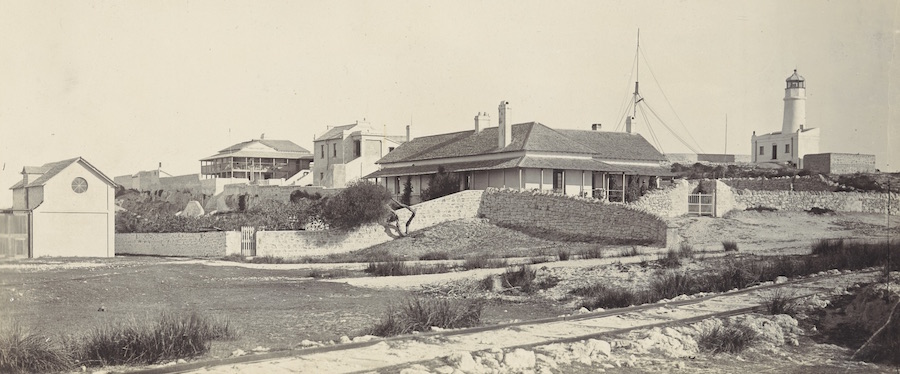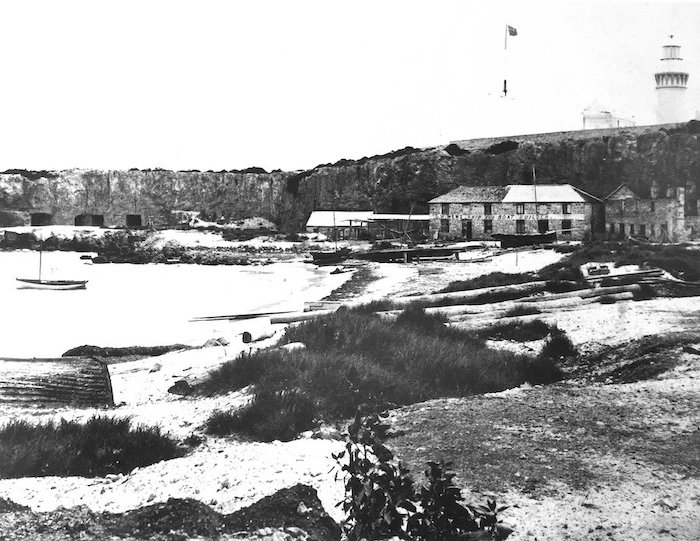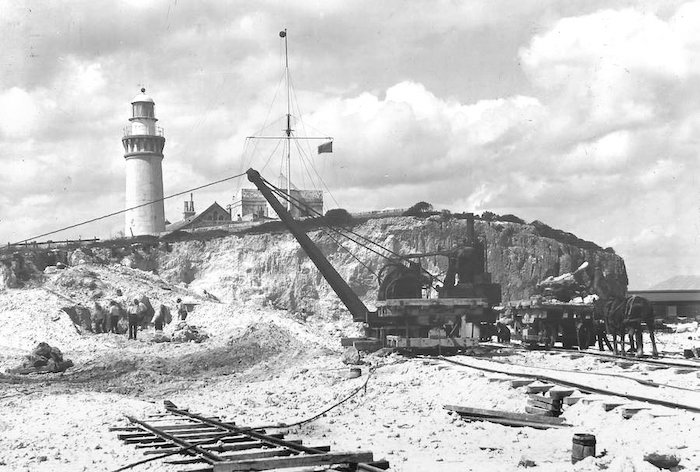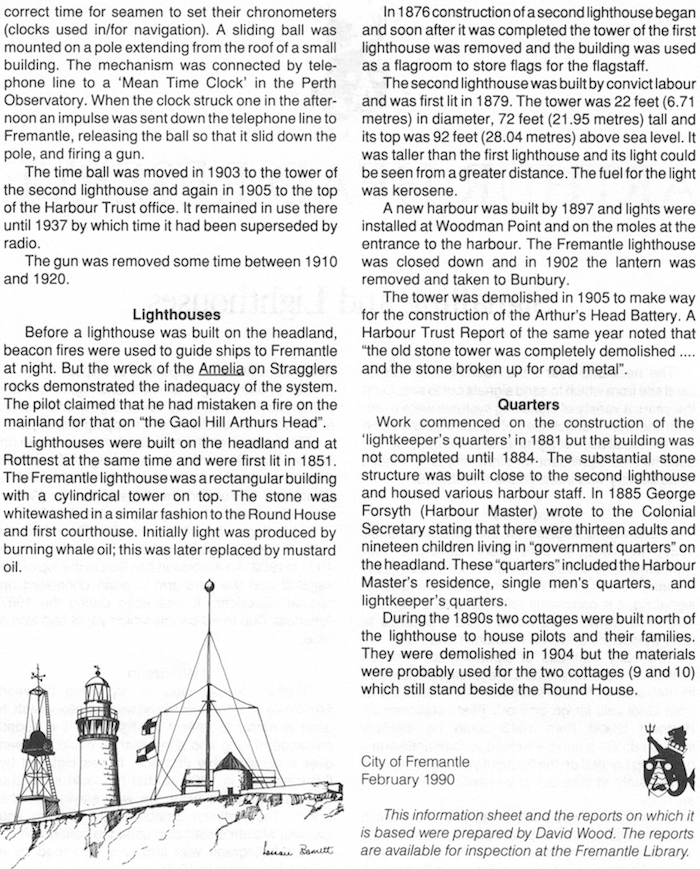

Freotopia > Arthur Head > signalling and lighthouses.
See also: Rottnest lighthouse.
There were two lighthouses, both built by convicts, the first in 1850. The second was begun in 1876 and first lit in 1879. The first one was then reduced to its groundfloor rooms with a conical roof, and used to store flags. Whale oil was the fuel used for the first light, later replaced by mustard oil.

Arthur Head c. 1870, with the first lighthouse on the right.
The large building in the centre is the Government Quarters aka the Residency, which was built in 1856 (Dowson has 1851) for the Water Police and demolished in 1967. To the left is the second courthouse, left of which may be seen the steps going up to the Round House. To the left again is the harbourmaster's house. The photo (WAHS R2775) is beautifully reproduced in John Dowson's Old Fremantle, pages 26 and 27. The photo is also available from the Fremantle Library Local History Collection #1801, and the Library text is as follows (with emphasis added).
The Residency first appears on a plan dated 1856, built for the Water Police. It was demolished in 1967. The lighthouse was erected in 1850 by convict labour. About 1876 the tower was cut down and the stump covered with a conical roof. The flagstaff was originally at Anglesea Point and was moved to Arthur Head before 1837. The house in the left background with the verandahs was the Harbour Master's house. Between it and the Residency is the second court house. Reproduced from Twentieth Century Impressions of WA, [P.W.H. Thiel & Co., Perth] 1901. Taken before 1876.

The second lighthouse was 22' in diameter, 72' tall, with its top 92' above sea level, and burnt kerosene. (The remains of the first lighthouse can be seen on the extreme left of this photo.)
A lighthouse on Arthur Head was no longer required after the construction of the new harbour with lights on the moles at its entrance, and another light at Woodman Point. The lantern was removed in 1902 and taken to Bunbury. The tower was demolished in 1905 to make place for the construction of the Arthur Head Battery.

Modern map indicating the position of former structures. The first lighthouse is indicated by 20, while the second was at 22. The rock on which they stood has been quarried away.

Photo reproduced in Hitchcock's 1929 History, page 148. His caption describes the scene as 'old lighthouse and shipyard, about 1865'. The building on the left is, as the sign says, Thomas Mews' premises. The right-hand building, demolished in the 1890s, is the ruin of the Fremantle Whaling Company (est. 1837) building. Hitchcock's 'old lighthouse' is ambiguous - as that is actually the second lighthouse, completed in 1879, so his date is misleading. The remains of the 1851 lighthouse can be seen just to the left of the newer one.

Library:
Bathers Bay RWAHS UN731. This photo is also available from the Fremantle Library Local History Collection as photo #2034A by S.M. Stout, c. 1890 [sic: Stout died in 1886]: The second lighthouse (1876/1878-1905) built on Arthur Head is to the right. Below is the TW Mews shipyard in Bathers Bay, established between 1840 and 1860. Next to the right is the abandoned building of the Fremantle Whaling Company, demolished in the 1890s.

Quarrying from what is now the approximate site of J Shed. Source and date unknown, but it is after 1879, when the second lighthouse was first lit, and also after 1903, when the timeball was moved to the remains of the first lighthouse, which is visible near the centre of the photograph, with flagstaff.
The Arthur Head Collection was a project coordinated by the City of Fremantle with funding from a grant available from the Federal Government to celebrate the Bicentennial year in 1988 [resulting in] a huge collection of materials in various formats including documents, reports, photographs, maps, bibliographies etc. to help research the site. ... Pam Harris, Librarian, Fremantle History Centre. May 2018.
The City Council in 1990 published a folder containing a summary of the research Pam Harris mentions above, consisting of a page about each of these buildings. This is one of them. David Wood:
The headland west of the Round House was an ideal site from which to send signals out to sea. Over the years a variety of signalling systems were used. With the new technologies of telephone and radio and the installation of lights for the new port, the site became less significant for signalling and Arthur's Head Battery was installed there (1905-06).
Flagstaffs
There was a flagstaff on the headland before 1837; in 1839 tenders were advertised for 'semaphores' for Fremantle. Perth and Preston Point. A semaphore is a pole with a movable arm used for signalling; it is commonly referred to as a flagstaff. The three semaphores would make it possible to relay messages between Fremantle and Perth.
The early methods of signalling to ships off Fremantle were very simple. Regulations published in 1846 stated: "When Harbour Master makes signal from Gaol Hill, let go anchor". Pilots stationed on Rottnest Island from 1848 could be similarly instructed: "On a gun being fired at Fremantle and a ball being hoisted on the flagstaff you will come over immediately to take out any vessel requiring your services."
During the nineteenth century the signalling system became more sophisticated as the following instructions show: "A black ball at the mast head of flagstaff denotes a steamer in sight from Rottnest. A blue flag hoisted at north or south yard-arm denotes whether such steamer is north or south of Rottnest. When the yard-arm flag is hauled down, it denotes that the pilot has boarded. As soon as the vessel's rig can be determined from Fremantle, the blue flag will be hauled down from the mast head and the corresponding distinguishing flag hoisted instead."
The signals with which the Harbour Master communicated with pilots and ships also provided the people of Fremantle and Perth with information about the arrival and departure of ships.
Even today flags, shapes and lights on the Fremantle Port Authority tower signal information about weather conditions and shipping movements.
The flagstaff on the headland was also used on special occasions. For the opening of St John's Church in 1843, Lieutenant Helpman of H.M.S. Champion "decorated the flagstaff on its (Arthur Head’s] summit with every flag he could find”.
A new flagstaff was built west of the Round House in 1986. It is similarto the one which stood there from 1905 tol 929. An Australian flag flies at the top of the flagstaff and the yard-arm is often decorated on special occasions. It was used during the 1987 Americas Cup to tell people which yacht had won a race.
Heliograph
Another device used for signalling between Fremantle and Rottnest Island was the heliograph. It used a mirror to reflect sunlight and the coded message of long and short flashes could be seen over a considerable distance. It was installed by Governor Ord in 1880 so that he could send and receive messages when he was staying on the island. The Rottnest Establishment (prison) and Harbour Master's staff also used the heliograph. The heliograph was largely superseded by a telephone system in 1900.
Signal Station
A signal station on the headland served a variety of purposes. It housed the heliograph and from 1905 to 1929 it was used by staff attending the flagstaff close by. After 1929 the signal station became a command post for the Arthur’s Head Battery.
Time Ball
From 1900 a time ball was used to signal the correct time for seamen to set their chronometers (clocks used in/for navigation). A sliding ball was mounted on a pole extending from the roof of a small building. The mechanism was connected by telephone line to a 'Mean Time Clock’ in the Perth Observatory. When the clock struck one in the afternoon an impulse was sent down the telephone line to Fremantle, releasing the ball so that it slid down the pole, and firing a gun.
The time ball was moved in 1903 to the tower of the second lighthouse and again in 1905 to the top of the Harbour Trust office. It remained in use there until 1937 by which time it had been superseded by radio. The gun was removed some time between 1910 and 1920.
Lighthouses
Before a lighthouse was built on the headland, beacon fires were used to guide ships to Fremantle at night. But the wreck of the Amelia on Stragglers rocks demonstrated the inadequacy of the system. The pilot claimed that he had mistaken a fire on the mainland for that on "the Gaol Hill Arthurs Head".
Lighthouses were buitt on the headland and at Rottnest at the same time and were first lit in 1851. The Fremantle lighthouse was a rectangular building with a cylindrical tower on top. The stone was whitewashed in a similar fashion to the Round House and first courthouse. Initially light was produced by burning whale oil; this was later replaced by mustard gas.
In 1876 construction of a second lighthouse began and soon after it was completed the tower of the first lighthouse was removed and the building was used as a flagroom to store flags for the flagstaff.
The second lighthouse was built by convict labour and was first lit in 1879. The tower was 22 feet (6.71 metres) in diameter, 72 feet (21.95 metres) tall and its top was 92 feet (28.04 metres) above sea level. It was taller than the first lighthouse and its light could be seen from a greater distance. The fuel for the light was kerosene.
A new harbour was built by 1897 and lights were installed at Woodman Point and on the moles at the entrance to the harbour. The Fremantle lighthouse was closed down and in 1902 the lantern was removed and taken to Bunbury.
The tower was demolished in 1905 to make way for the construction of the Arthur's Head Battery. A Harbour Trust Report of the same year noted that The old stone tower was completely demolished .... and the stone broken up for road metal".
Quarters
Work commenced on the construction of the 'lightkeeper's quarters' in 1881 but the building was not completed until 1884. The substantial stone structure was built close to the second lighthouse and housed various harbour staff. In 1885 George Forsyth (Harbour Master) wrote to the Colonial Secretary stating that there were thirteen adults and nineteen children living in "government quarters" on the headland. These "quarters" included the Harbour Master’s residence, single men's quarters, and lightkeeper's quarters.
During the 1890s two cottages were built north of the lighthouse to house pilots and their families They were demolished in 1904 but the materials were probably used for the two cottages (9 and 10) which still stand beside the Round House.
City of Fremantle February 1990
This information sheet and the reports on which it is based were prepared by David Wood. The reports are available tor inspection at the Fremantle Library.


A heliograph is in essence a mirror used to flash light signals. Heliograph derives from two Greek words: ‘sun’ and ‘writing’. Signals can either be prearranged or messages can be sent by morse code using combinations of short and long flashes of light. A small hand mirror could be used for short distances but might be tiring to use for long messages.
The heliograph on display, which was used to signal from Rottnest Island to Fremantle, is a more elaborate form of the simple device. It uses a 25 cm diameter mirror and a key (similar to a telegraph key) which, through a simple mechanism, allows the mirror to be tilted simply by touching the key with a finger.
For the first 50 years of settlement communication between Rottnest and Fremantle was by signal flags during the day and by signal fires at night.
Governor Sir Harry St George Ord arrived in the Colony in 1877. He liked Rottnest and was soon spending about a quarter of his time there. Soon after his arrival he urged the laying of a telegraph cable between Rottnest and Fremantle but this proved too expensive an undertaking for the Colony. In 1878 there was an unsuccessful attempt to establish a mechanical semaphore system. Ord then proposed a heliograph. A set of four heliographs arrived in July 1879. They cost $50 (£25) each. In 1880 when Sir William Robinson became Governor in succession to Ord, the heliographs were put under the control of the Post and Telegraph Department.
The heliograph on Rottnest was mounted on a rise, since known as Signal Hill, handy to Government House. The Fremantle heliograph was beside the lighthouse on Arthur Head.
The first Rottnest operator was Henri Courderot, a Frenchman, who was overseer of the salt works and clerk to the Prison Superintendent. He was paid $20 (£10) a year for operating the heliograph. In 1886 his pay was raised to $40 (£20) per year.
Telegraphists from the Fremantle post office operated the instrument on Arthur Head. Heliographs could only be used in sunny weather and this was reflected in the granting of a $10 (£5) gratuity to the Fremantle telegraphist for summer overtime work.
Communication between Rottnest and the mainland was not improved until after the tragic sinking of the City of York, wrecked on Rottnest in 1899. Faulty signalling by the lighthousekeeper was one cause of the ship being wrecked and 11 being drowned.
Premier John Forrest soon promised either wireless or telegraph communication, or a telephone cable A single circuit telephone cable was laid in 1900. Although the heliographs were no longer needed, one was still at Rottnest in 1914. In October 1914 Leslie Pym, chief signalman on Rottnest for the Fremantle Harbour Trust, reported that he would use the heliograph in emergencies, if the telephone cable was out of action, during the War. (World War I had broken out in August of that year.) The telephone cable proved reliable and the heliograph was not called in to use until 1931 while the cable was under repair for several weeks. It is possible that the heliograph was sometimes used during World War II.
The station on Rottnest was closed in 1949. Fortunately one heliograph from Rottnest was kept in store by the Fremantle Harbour Trust until it was donated to the Western Australian Museum in 1968.
References
Moynihan, John (1970). Twelve miles west of Fremantle, Australian Post Office Magazine, 17:1.
Moynihan, John (1977). All the news in a flash. The West Australian, 21 June 1977.
as above
Two lighthouses in the Albany area were those at Breaksea and Point King.
Garry Gillard | New: 30 April, 2016 | Now: 8 May, 2024